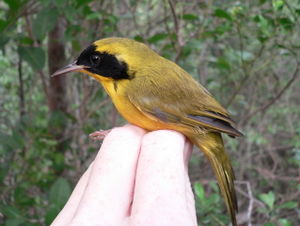Bahamian yellow throat
| Bahamian yellow throat | ||||||||||||
|---|---|---|---|---|---|---|---|---|---|---|---|---|

Bahamian yellow throat ( Geothlypis rostrata ) |
||||||||||||
| Systematics | ||||||||||||
|
||||||||||||
| Scientific name | ||||||||||||
| Geothlypis rostrata | ||||||||||||
| Bryant , 1867 |
The Bahamian yellow throat ( Geothlypis rostrata ) is a small songbird from the wood warbler family (Parulidae).
features
Bahamian yellow throats reach a body length of 15 centimeters and weigh 15.1 to 17.3 grams. The wing length is 6 to 6.7 centimeters in the male and 5.7 to 6.3 centimeters in the female. Adult male Bahamian yellow throats of the nominate form have a black face mask that is connected to one another over the beak, an adjacent gray-white forehead band that extends to the ear covers and a gray crown plumage. The neck is olive gray; the sides of the neck and top plumage are olive green. The wings are dull brown with olive feather edges and the underside plumage is yellow, which is a little more dull on the belly and can sometimes be white. The plumage on the flanks is olive-washed. The beak is black; the legs flesh-colored. With a length of 1.5 to 1.7 centimeters, they have the largest and heaviest beak within the Geothlypis genus .
The adult female Bahamian yellowthroat is missing the black face mask and the forehead band. Neck and crown are gray to olive gray; the sides of the head slightly dull olive gray, especially on the reins . There is a narrow, white stripe under the eye. The upper side plumage is slightly olive and the body and tail feathers are light olive. Throat and chest plumage are pale yellow, the flanks washed out olive and the belly and the under tail-covers whitish. Females of the subspecies have a similar appearance. Male individuals of the subspecies Geothlypis r. coryi usually have a yellow-white forehead crown band; Male of the subspecies Geothlypis r. tanneri a tinted, yellow forehead crown band.
Occurrence, nutrition and reproduction
Bahamian yellow throats are endemic to the Bahamas . They live singly or in pairs in dense scrub and shrubbery in dry regions and areas overgrown with ferns. Their diet consists mainly of insects and other invertebrates . They lay their bowl-shaped nest well hidden in the dense vegetation on the ground or in a tree stump. The clutch consists of two eggs. More detailed studies of the breeding behavior are not known.
Subspecies and distribution
Together with the willow yellow throat ( Geothlypis trichas ), the Belding yellow throat ( Geothlypis beldingi ) and the yellow crowned yellow throat ( Geothlypis flavovelata ) the Bahama yellow throat forms a super species .
There are three recognized subspecies:
- Geothlypis r. rostrata H. Bryant , 1867 - Andros and New Providence
- Geothlypis r. coryi Ridgway , 1886 - Eleuthera and Cat Island
- Geothlypis r. tanneri Ridgway, 1886 - Grand Bahama , Great Abaco ( Abaco ) and the associated islets near the coast
Endangerment status
In Andros and New Providence the nominate form is Geothlypis r. rostrata rarely found. There are no current development trends. They are currently not considered threatened by the bird protection organization BirdLife International . They are listed as “Least Concern” by the IUCN .
swell
literature
- Jon Curson, David Quinn, David Beadle: New World Warblers. Helm, London 1994, ISBN 0-7136-3932-6 .
Web links
- Geothlypis rostrata in the endangered Red List species the IUCN 2008. Posted by: BirdLife International, 2008. Accessed January 27 of 2009.
- Bahamian yellow throats at BirdLife International
- Bahamian yellow throats at ITIS